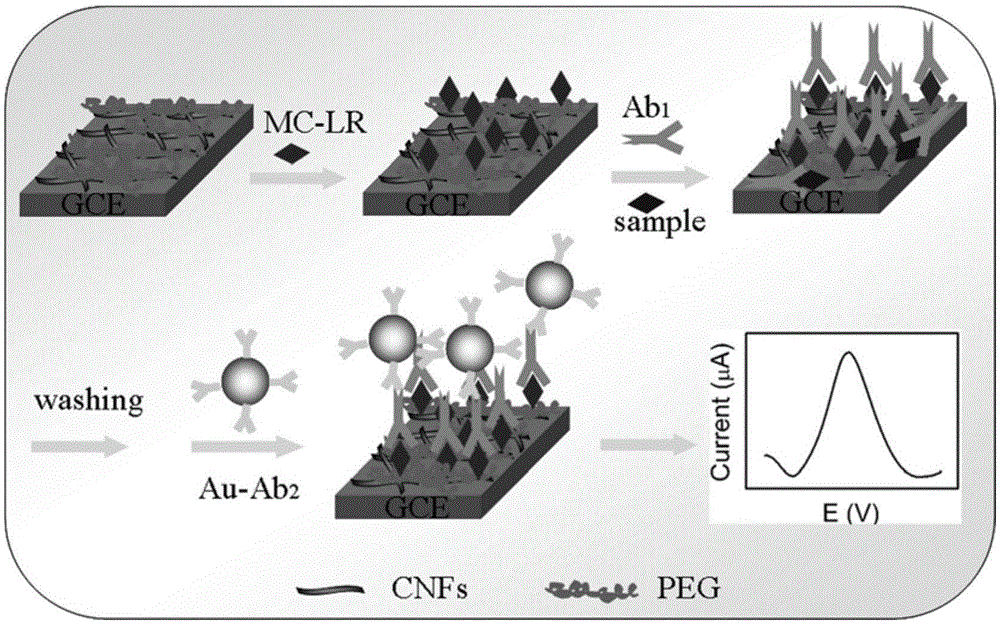Microcystin-LR detecting method based on enzyme-free immuno-sensor
A microcystin and sensor technology, applied in the field of immunoanalysis chemistry, can solve the problems of undrinkable, complicated processing process, high detection cost, etc., and achieve the effect of online detection, high sensitivity and low cost
- Summary
- Abstract
- Description
- Claims
- Application Information
AI Technical Summary
Problems solved by technology
Method used
Image
Examples
Embodiment 1
[0039] Preparation of carboxylated carbon nanofibers
[0040] a. Disperse 40 mg of carbon nanofibers with a diameter of 60 nm in 60 mL of HNO with a solute mass fraction of 30% 3 In the solution, mix and ultrasonically stir evenly;
[0041] b. Reflux the mixed solution obtained in step a in an oil bath at 140°C for 24 hours;
[0042] c, filtering and washing until the pH is 7.0 to obtain carboxylated carbon nanofibers with better water solubility;
[0043] d, preparing a dispersion of carboxylated carbon nanofibers prepared in step c of 1 mg / mL;
Embodiment 2
[0045] Preparation of gold nanoparticles and its labeled goat anti-mouse antibody
[0046] a. Heat 50mL of chloroauric acid solution with a mass concentration of 0.01% to boiling, and quickly add 1.75mL of trisodium citrate solution with a mass concentration of 1% to it under vigorous stirring, and continue the reaction for 10 minutes to obtain a brick with a particle size of 13nm Red gold nanoparticle colloidal solution;
[0047] b, get the gold nanoparticle colloidal solution 1mL that step a obtains and use 0.1M K 2 CO 3 After adjusting the pH to 9.0, add 25 μL of 1 mg / mL goat anti-mouse antibody, and stir at room temperature for 2 h;
[0048] c. First filter the above mixture, centrifuge and wash the obtained precipitate three times with 0.01M (pH7.4) phosphate buffer solution, and disperse it with 300 μL of phosphate buffer solution with a concentration of 1% bovine serum protein to obtain the labeled goat anti-mouse Antibody gold nanoparticles (gold nanoparticle probes...
Embodiment 3
[0050] Preparation and detection steps of MC-LR immunosensor
[0051] Glassy carbon electrodes with a diameter of 3mm pass through 0.3μm and 0.05μm Al 2 o 3 After the powder is polished, it is thoroughly ultrasonically washed in ethanol and deionized water in turn to obtain a smooth and clean electrode.
[0052] After dripping 5 μL of the dispersion of carboxylated carbon nanofibers prepared in Example 1 on the dried above-mentioned electrode, then drop-coating 5 μL of 2 mg / mL polyethylene glycol-20000 dispersion, and saturated water at 4 ° C Place it in a steam environment overnight, and form a layer of polyethylene glycol film by physical adsorption;
[0053] 10 μL of 500 μg / L MC-LR antigen was added dropwise on the surface of the modified electrode treated above, and after physical adsorption in a 25°C wet box for 1 hour, the modified electrode was rinsed with phosphate Tween buffer (0.05% Tween-20) with a pH of 7.4. After the electrode, 10 μL of bovine serum albumin sol...
PUM
 Login to View More
Login to View More Abstract
Description
Claims
Application Information
 Login to View More
Login to View More - R&D
- Intellectual Property
- Life Sciences
- Materials
- Tech Scout
- Unparalleled Data Quality
- Higher Quality Content
- 60% Fewer Hallucinations
Browse by: Latest US Patents, China's latest patents, Technical Efficacy Thesaurus, Application Domain, Technology Topic, Popular Technical Reports.
© 2025 PatSnap. All rights reserved.Legal|Privacy policy|Modern Slavery Act Transparency Statement|Sitemap|About US| Contact US: help@patsnap.com


